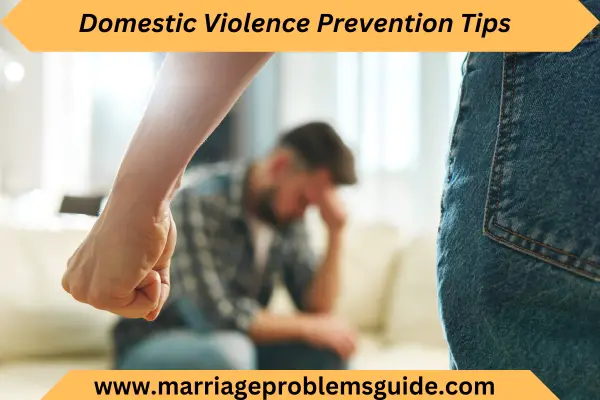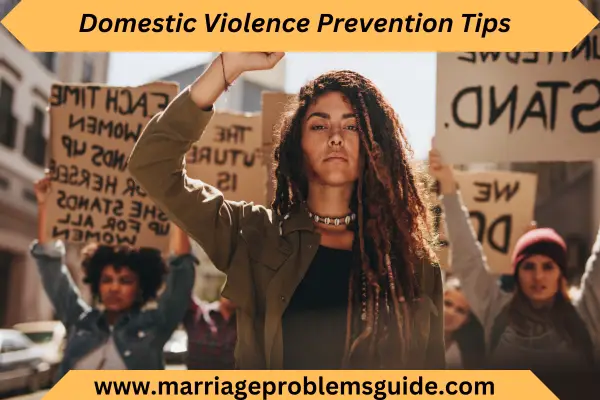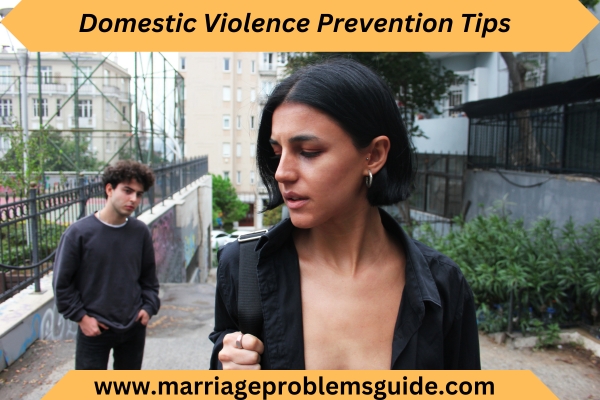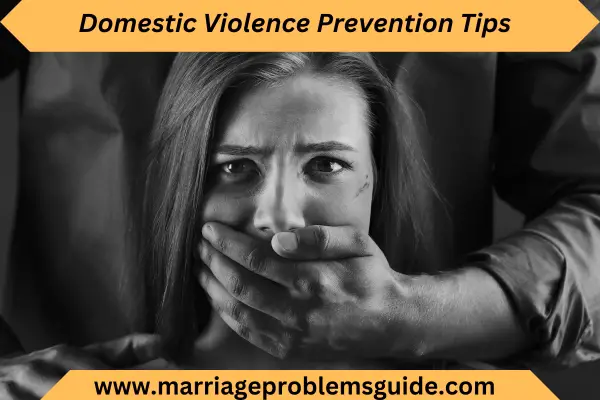Domestic Violence Prevention Tips
Domestic violence is a distressing reality that impacts millions globally. While there are no foolproof ways to completely prevent domestic abuse, experts agree there are steps you can take to reduce the risk and better protect yourself and loved ones.
In this blog article, we will provide 15 practical, research-backed domestic violence prevention tips from advocates, counselors, and specialists in the field.
What is Domestic Violence?
Domestic violence refers to a pattern of abusive behaviors by one partner in an intimate relationship to exert power and control over the other. It can encompass physical, sexual, emotional, economic and psychological abuse.
According to the National Domestic Violence Hotline, domestic abuse includes behaviors like:
- Physical abuse – Hitting, slapping, punching, choking, burning, etc. Any type of physical harm inflicted by a partner.
- Sexual abuse – Forcing unwanted sexual acts, refusing protected sex, reproductive coercion, sexual degradation, marital rape.
- Emotional abuse – Constant criticism, gaslighting, humiliation, isolation from friends/family, controlling activities.
- Economic abuse – Interfering with a partner’s ability to work, restricting access to bank accounts, running up debt in their name.
- Psychological abuse – Intimidation through threats/gestures, destruction of property, harming pets, obsessive jealousy.
Domestic violence is always about establishing control over one’s partner through fear, shame or dependency. It often escalates from subtly coercive behaviors to severe violence over time.

The Signs and Symptoms of Domestic Violence
Domestic abuse manifests through various behaviors and their effects on the victim. Below are some common signs:
- Physical injuries like bruises, broken bones, head injuries, burns. Victims may have injuries in hidden areas or give reasons that don’t match the harm caused.
- Depression, anxiety, PTSD – Victims often suffer from mental health issues due to trauma from prolonged abuse.
- Apologizing/defending the abuser – Victims may protect the abuser out of fear, denial or from the manipulation involved in domestic violence relationships.
- Low self-esteem – Abusers constantly insult and criticize victims, leaving them feeling worthless, desperate and dependent on the abuser.
- Isolation from family/friends – A tactic abusers use to control victims and limit their external support system.
- Fear of conflict – Victims may become passive and fearful of upsetting their partner to avoid triggering abuse.
- Missing time at work/school – Victims often miss time for work or school to recover from injuries or due to depression/anxiety.
Recognizing these signs early is important to prevent escalation and further harm.

The Effects of Domestic Violence on Victims and Their Families
The trauma of domestic violence has severe effects on the victim that can last long after the abuse. Some common consequences include:
- Injuries like bruises, broken bones, permanent disabilities, disfigurement. In severe cases, abuse may lead to murder.
- Mental health issues – Depression, anxiety, PTSD, suicidal thoughts are extremely common among abuse victims.
- Lost careers/educational opportunities – Victims are often held back financially and unable to achieve their full potential.
- Substance abuse – Some victims turn to alcohol/drugs to numb the emotional pain of abuse.
- Damage to children – Growing up in an abusive home negatively affects child development and mental health.
- Generational cycles of abuse – Children who grow up witnessing domestic violence are more likely to end up in abusive relationships or become abusers themselves.
Breaking this cycle and mitigating the extensive emotional, physical and psychological damage of domestic violence should be a priority.

Why is it Important to Prevent Domestic Violence?
Preventing domestic abuse is crucial for several reasons:
- Protects health and saves lives – Early intervention can prevent violence from escalating and causing severe physical/mental harm or death.
- Avoids trauma to children – Stopping domestic violence early on avoids lifelong trauma and adverse health effects for children exposed to it.
- Prevents abuse cycles – Preventing domestic violence from continuing across generations is vital to end these destructive cycles.
- Promotes safety and equity – Preventing abuse fosters safer homes, relationships and communities that uphold human rights.
- Alleviates costs – The healthcare, legal and lost productivity costs of domestic violence amount to billions yearly. Prevention alleviates these costs.
- Upholds ethics and values – Allowing abuse to continue conflicts with society’s ethics and basic human rights values. Prevention aligns with moral obligations.
With early recognition, intervention and education, many instances of domestic violence can be mitigated or stopped completely. This avoids substantial harm and suffering while promoting non-violence and equality.
15 Expert Tips for Domestic Violence Prevention
#1. Recognize Warning Signs of an Abuser Early On
Abusers often don’t start out abusive. Coercive and controlling behaviors tend to emerge and escalate over time.
Be alert to potential red flags like jealousy, possessiveness, verbal putdowns, and isolation from friends and family. Pay attention if your partner tries to rush commitment early on and doesn’t respect your boundaries.
While concerning behaviors don’t always lead to abuse, early recognition can help you make informed choices about the relationship.
#2. Assert Your Needs and Set Boundaries
Don’t ignore behaviors that make you uncomfortable. Communicate clearly if your partner is acting in ways you find unacceptable.
Setting boundaries demonstrates self-respect and helps prevent abusive patterns from normalizing. For instance, if belittling comments bother you, confront your partner and ask them to speak to you more kindly.
#3. Stay Connected with Loved Ones
Abusers often try isolating their partner from outside support. Combat this by nurturing close relationships with family and friends. Don’t cut contact due to a partner’s objections.
Stay engaged in activities and communities you enjoy. Maintaining social connections provides a support system and makes it harder for an abuser to gain control.
#4. Keep Your Finances Separate
Financial abuse is common in domestic violence cases. Protect your assets by avoiding joint bank accounts and credit cards. Don’t let your partner pressure you into giving them access.
If possible, maintain your financial independence. Have a source of income and savings your partner can’t access or control. This safeguards your options if you need to leave.

#5. Have an Exit Plan Ready
Experts stress having an exit strategy in case you need to urgently flee abuse. Know exactly where you would go and how to get there. Prepare an emergency bag with vital documents, medications, cash, and a few personal items.
Memorize key phone numbers, including domestic violence resources. Having an exit plan empowers you to leave a dangerous situation quickly.
#6. Review Your Safety Measures
Domestic violence safety planning is vital, whether currently experiencing abuse or not. Identify ways to stay safe at home, such as avoiding rooms with potential weapons.
Come up with coded signals you can use to alert friends or family in an emergency. Know your local laws and what actions qualify as abuse.
Regularly review and update your plan to maximize your safety. Reach out to a domestic violence advocate for guidance crafting strategies tailored to your situation.
#7. Practice Self-Care and Stress Management
Make self-care a priority. Things like exercise, healthy eating, meditation, and fulfilling hobbies support emotional health. This builds resilience and self-esteem, making you less vulnerable to manipulative abuse tactics.
Learn constructive stress management skills as well. For instance, take time to cool down when angry before continuing a discussion. Manage stress effectively to avoid triggering aggressive reactions from your partner.
#8. Attend a Batterer Intervention Program
If your partner exhibits abusive tendencies, don’t ignore it. Issuing ultimatums won’t stop the behavior long-term.
Experts strongly recommend having them attend an accredited batterer intervention program (BIP). BIPs use counseling and education to promote accountability and stop violence.
This domestic violence prevention approach addresses abusive behaviors at the root. Note that your partner has to enroll voluntarily for BIPs to work.
#9. Call Out Abusive Actions by Friends/Family
Don’t overlook abusive behaviors by those close to you, even if it seems harmless. Laughing off demeaning jokes or controlling behavior enables it to continue and worsen.
Take a stand by pointing out the abuse. For example, tell someone “Don’t speak that way to your wife, it’s unacceptable.” Speaking up establishes intolerance for domestic violence in your social circle.
#10. Volunteer with Local Prevention Efforts
Get involved in community initiatives working to prevent domestic abuse. Look for volunteer opportunities with women’s shelters, clinics, crisis hotlines, and advocacy groups.
You can help run support groups, staff helplines, distribute resources, assist victims filing protection orders, and other efforts that enact change locally.
#11. Know Signs of Strangulation Risk
Strangulation is one of the most lethal forms of domestic abuse. It’s also underestimated, as neck injuries aren’t always visible.
Learn signs of strangulation danger, like your partner choke holding you “playfully” or grabbing your neck during arguments. Take all choking threats seriously and tell a loved one.
#12. Create a Safety Code Word with Kids
Teach kids a secret code word they can use to signal the need for help in a domestic violence situation. For example, “red cupcake” could mean to leave the house immediately and call for emergency assistance.
Roleplay different scenarios so children remember to use the safety word if needed. This empowers kids to discreetly get to safety when violence erupts at home.
#13. Keep Weapons like Guns Removed
Where there’s past domestic abuse, access to firearms sharply increases homicide risk. To prevent injury and death, experts strongly recommend surrendering guns and other weapons.
You can call local law enforcement for help safely removing firearms from an abusive home. This eliminates easy lethal means when emotions and violence escalate.
#14. Know Your Local and Legal Protections
Familiarize yourself with laws and resources in your area so you know where to turn for help. Learn the process for getting a protection order and know domestic violence shelter options.
Stay up-to-date on city ordinances, programs, and other developments relevant to domestic abuse prevention and response.
#15. Reach Out for Professional Support
Seeking guidance from domestic violence hotlines, counselors, and advocates is encouraged even if not in immediate danger. They can help assess your risks, plan for safety, and process complex emotions around abuse issues.
If your partner won’t get help, consider contacting domestic violence professionals yourself. They can offer specialized support and expertise to help improve your situation.
Conclusion:
While completely eliminating domestic violence isn’t feasible, taking preventative measures lessens the risks substantially. When individual efforts aren’t enough, professional advocacy and community-based solutions can also enact positive change.
If you or someone you know is experiencing domestic abuse, confidential help is available 24/7 via the National Domestic Violence Hotline at 1-800-799-SAFE (7233). Call 911 immediately if you are in imminent danger. Learn here more domestic violence guide and tips.


